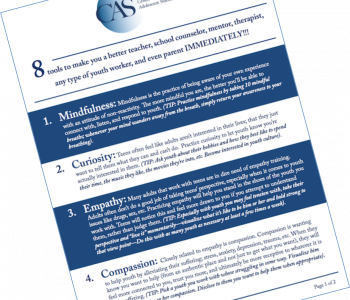

Catharine Hannay, MA
Catharine Hannay is the founder of MindfulTeachers.org and the author of Being You: A Girl’s Guide to Mindfulness, a workbook for teen girls on mindfulness, compassion, and self-acceptance.
How Can I Better Support Immigrant and Refugee Youth?
They lost one of the Lost Boys on a trip to the zoo.
The ‘Lost Boys’ were kids who fled southern Sudan, starting in 1987 with an original group of around 20,000 children (many as young as six years old) who “walked more than a thousand miles, half of them dying before reaching Kakuma refugee camp in Kenya.” (International Rescue Committee) Fewer girls than boys survived, and many of the girls who did survive faced exploitation in refugee camps. (VOA News)
In 2001, when around 3600 boys and 89 girls were resettled in the U.S, a colleague told me this story:
A couple of volunteers decided to organize a fun outing for the youth who’d recently arrived in their community.
Hmm, where should they go? Well, everybody enjoys visiting the zoo, right?
About halfway through the tour, they noticed that one of the guys wasn’t with the rest of the group. So they retraced their steps, and they eventually found him near the Big Cats enclosure.
When they saw what he was doing, they realized how badly they’d misjudged the situation.
He was gathering rocks to throw at the lions.
This was a natural reaction from someone who’d never seen a zoo before and who’d witnessed or survived a lion attack.
The volunteers were well-intentioned, but they were in over their heads.
If you work with immigrants, and especially with refugees and asylum seekers, it’s essential to understand the ways they may been impacted by trauma, as well as the complexities of adjusting to a new society.
There are many resources here at the Center for Adolescent Studies on working with trauma-impacted youth, including the following posts:
- A Critical Intervention for Working with Traumatized Youth
- The Four Essentials of Being a Trauma-Informed Youth Professional
- How Our Own ACEs Impact Trauma Work with Youth
- Trauma and the Brain: An Introduction for professionals working with teens
- Trauma-Informed Mindfulness with Teenagers
In today’s post, I’d like to focus on the types of challenges faced by migrants, refugees, and asylum seekers, and how you can help them adjust to life in their new culture.
Multiple Challenges and Multiple Forms of Trauma
According to Amnesty International:
- “Some migrants leave their country because they want to work, study or join family. Others feel they must leave because of poverty, political unrest, gang violence, natural disasters or other serious circumstances that exist there.”
- “A refugee is a person who has fled their own country because they are at risk of serious human rights violations and persecution […and] their own government cannot or will not protect them from those dangers.”
- “An asylum seeker is a person who […] hasn’t yet been legally recognized as a refugee and is waiting to receive a decision on their asylum claim.”
While in their country of origin, or while in transition to a host country (including long journeys on foot and/or time spent in a refugee camp), migrants, refugees, and asylum seekers may experience:
- disrupted schooling;
- lack of basic resources, including food, water, shelter, and medical care; and
- acts of violence, including war, torture, and sexual assault.
After relocating to a new country, they may experience:
- loneliness;
- culture shock;
- difficulty learning a new language;
- discrimination, including racism and religious bigotry;
- poverty, including lack of adequate housing and transportation; and
- loss of social status (depending on their family’s position in their country of origin).
Many youth face additional stressors:
- They may need to take on an adult role within the family (for example, interpreting for parents);
- If they’re d/Deaf or hard-of-hearing, they may need to learn a new signed language as well as a new written and spoken language;
- Unaccompanied minors are vulnerable to abuse and exploitation; and
- Asylum seekers don’t know whether they’ll be able to remain in the host country; they could be returned to their native country, to face the same conditions they were trying to escape. (See, for example: UNHCR calls on States to refrain from forced returns of Haitians)
Give Them the Benefit of the Doubt
In a previous post, I mentioned some of the communication issues that can arise with non-Native speakers of English. It’s also important to realize that body language and gestures can have very different meanings in different cultures.
A student told me that his friend got in a lot of trouble for flipping off the lunch lady. He had no idea what he’d done wrong until someone explained to him the difference between ‘thumbs down’ and ‘middle finger up.’
He’d noticed that both gestures were used negatively. He hadn’t understood that only one of those gestures was acceptable when declining a particular item in the lunch line. Nor had he realized there were words and gestures the American students used with each other but not in front of adults.
There was nothing about that whole situation that was the same in his home country, from the behavior of his classmates to the food being served in the cafeteria.
Depending on their background, immigrant youth may be baffled not only by food and gestures, but also by the transportation system and the way people are dressed, not to mention gender roles and the treatment of elders, among many other possible differences. Adding to the confusion, they may watch popular TV shows about teens which show behavior that’s not acceptable at their real-life school.
If young people from another culture appear to be misbehaving, it may be because they don’t recognize or understand the rules, not because they’re intending to break them.
“My head ached […] trying to make sense of myself when I was so far from anything I knew.”
Uprooted, Naomi Novik, p. 229
Focus on Their Strengths, Not Just Their Challenges
Maud Easter and Dina Refki point out that many immigrant youth have advantages over some of the native-born peers, including one or more of the following:
- Bilingualism;
- Resilience;
- Awareness of multiple cultures and perspectives;
- Supportive extended families, with guidance from multiple adults;
- “Emphasis on collective decision-making, yielding more effective teen conflict resolution”; and
- “Community needs valued over individual needs: buffering youth against materialistic, competitive pressures of mainstream US society and celebrating youth achievements as bringing pride to the whole community.”
They also note:
“while children in some countries may have to bear too much responsibility for their communities, generally children in mainstream US culture are not given enough social responsibility. Responsible community involvement of immigrant youth can model empowering options for other teens.”
(from “Creating Successful Programs for Immigrant Youth” at ACT for Youth)
For More Information
The following organizations have useful online resources:
Child Welfare Information Gateway has tips for working with youth who are immigrants and refugees;
The Migration Policy Institute has suggestions on how the child welfare system can better respond to the needs of children from immigrant families;
National Association of School Psychologists has tips for educators on supporting refugee children and youth;
The National Child Traumatic Stress Network has resources on culture and trauma; and
The UN Refugee Agency has current statistics on the refugee crisis.
It’s also a good idea to talk with people in your city or region who work outside of your profession. Social workers, healthcare providers, counselors/therapists, English teachers, clergy, and immigration lawyers have different types of training and expertise and will be aware of different types of resources. If you can find or develop a network of providers, you’ll be in a much better position to help the immigrant and refugee youth in your community.
To gather with a dynamic and intentional community of helping professionals dedicated to networking across professions and coming together to provide trauma-informed care and build authentic relationships with both colleagues and those we provide services to, join the FREE Training Community. Learn more and sign up here. It takes just 2 minutes!
Related Posts:
Add a Culturally-Aware Lens to Your Trauma-Informed Toolkit
How Can I Better Support Marginalized Youth?

